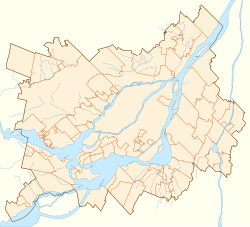Laflèche, Quebec
| Laflèche | |
|---|---|
| Neighbourhood | |

A typical intersection in Laflèche
|
|
| Coordinates: 45°29′46″N 73°28′30″W / 45.496°N 73.475°WCoordinates: 45°29′46″N 73°28′30″W / 45.496°N 73.475°W | |
| Country |
|
| Province |
|
| City | Longueuil |
| Borough | Saint-Hubert |
| Established | 1947 |
| Merger with Saint-Hubert | 1971 |
| Government | |
| • City Councillor | Jacques Lemire (Ind.) |
| Area | |
| • Land | 4.33 km2 (1.67 sq mi) |
| Population (2011) | |
| • Total | 17,499 |
| • Density | 4,041.3/km2 (10,467/sq mi) |
| • Change * |
|
| • Dwellings | 7,999 |
| Time zone | Eastern (EST) (UTC-5) |
| • Summer (DST) | EDT (UTC-4) |
| Website | www.ville.longueuil.qc.ca |
| Area code = 450 | |
Laflèche (originally known as Mackayville) is a neighbourhood in the Saint-Hubert borough of the city of Longueuil.
Laflèche is primarily a densely populated residential neighbourhood. It is largely low-income, and similar to Ville LeMoyne and other parts of the Le Vieux-Longueuil borough. Most buildings in the area are single-family homes, but there are also many small apartment buildings scattered throughout the neighbourhood. Boulevard Taschereau, Boulevard Édouard and Chemin de la Grande Allée are the main arteries in Laflèche, and all three feature numerous businesses.
Laflèche is reputed for its small house built with tar up planks taken from the rail industry. A good proportion of the first inhabitants of the neighbourhood worked at the Canadian National plant in Pointe-Saint-Charles, which made it easier for workers to carry large pieces of wood in Laflèche to build houses.
The oldest house of the neighborhood is on Duke street. It was built at the end of the 19th century.
Laflèche is a neighbourhood that was built mostly between 1930 and 1960. During the beginning of the 20th century, the territory was part of the Saint-Antoine de Longueuil Parish. Originally known as St-Lambert Heights, the name of the land was changed to Mackayville in honour of a Montreal notary who managed the development of the land in the 1920s.
With the opening of Jacques-Cartier Bridge in 1930 and the steadily increase of cars, many Montreal working families moved to the South Shore, including Mackayville.
Montreal and Southern Counties Railway had a tram stop in Mackayville at the corner Grande-Allée and Edouard. The building, which eventually became a Perette convenience store, still exists today.
...
Wikipedia

